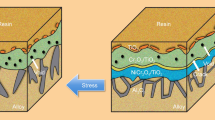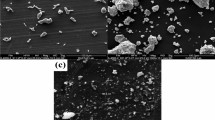Sheets from titanium alloys VT18U and Ti6Al7Nb are studied after isothermal annealing at 560°C for 1000 h in an air atmosphere. Tensile tests of the specimens are performed. The elongation of the samples of VT18U and Ti6Al7Nb is shown to differ substantially in oxidized condition. Metallographic, fractographic and x-ray diffraction analyses are performed for determining the main parameters affecting the ductility of the alloys in oxidized condition. The effect of the surface gas-saturated layer on the mechanical properties of the alloys is studied, and the factors influencing the ductility of the oxidized samples in tensile tests are determined.



Similar content being viewed by others
Change history
19 March 2020
The author affiliations should read
References
O. P. Solonina and S. G. Glazunov, Titanium Alloys. Refractory Titanium Alloys [in Russian], Metallurgiya, Moscow (1976), 448 p.
N. M. Pul’tsyn, Interaction between Titanium and Gases [in Russian], Metallurgiya, Moscow (1969), 216 p.
E. M. Lazarev, Z. I. Kornilova, and N. M. Fedorchuk, Oxidation of Titanium Alloys [in Russian], Nauka, Moscow (1985).
H. Garbacz and M. Lewandowska, “Microstructural changes during oxidation of titanium alloys,” Mater. Chem. Phys., 81, 542 – 547 (2003).
K. S. McReynolds and S. Tamirisakandala, “Study of alpha-case depth in Ti – 6Al – 2Sn – 4Zr – 2Mo,” Metall. Mater. Trans. A, 42, 1732 – 1736 (2011).
R. Gaddam, B. Sefer, R. Pederson, and M.-L. Antti, “Oxidation and alpha-case formation in Ti – 6Al – 2Sn – 4Zr – 2Mo alloy,” Mater. Charact., 99, 166 – 174 (2015).
P. Samimi, I. Ghamarian, D. Brice, et al., “Collins on the influence of compositional variations on the oxidation performance and oxygen-induced phase transformations in Ti-based systems,” in: Proc. 13th World Conf. on Titanium, The Minerals, Metals & Materials Society, San Diego (2015), pp. 1521 – 1526.
M. S. Kalienko, A. V. Volkov, and A. V. Zhelnina, “A study of gas-saturated layer in titanium alloys after isothermal annealing,” Zavod. Lab., Diagn. Mater., 84(3), 32 – 35 (2018).
P. J. Bania, “Next generation titanium alloys for elevated temperature service,” ISIJ Int., 31(8), 840 – 847 (1991).
B. Geary, V. J. Bolam, S. L. Jenkins, and d. P. Davies, “High temperature titanium sheet for helicopter exhaust applications,” in: Titanium’1995: Science and Technology, Proc. 8th World Conf. on Titanium, Birmingham (1995), pp. 1638 – 1645.
H. Fukai, H. IIzumi, K. Minakowa, and C. Ouchi, “The effect of the oxygen-enriched surface layer on mechanical properties of α + β type titanium alloys,” ISIJ Int., 45(1), 133 – 141 (2005).
R. A. Chan, M. Koike, B.W. Johnson, and T. Okabe, “Modeling of alpha-case formation and its effect on the mechanical properties of titanium alloy castings,” Metall. Mater. Trans. A, 39, 171 – 180 (2008).
A. L. Pilchak, W. J. Porter, and R. John, “Room temperature fracture processes of a near-α titanium alloy following elevated temperature exposure,” J. Mater. Sci., 47, 7235 – 7253 (2012).
R. Gaddam, M.-L. Antti, and R. Pederson, “Influence of alpha-case layer on the low cycle fatigue properties of Ti – 6Al – 2Sn – 4Zr – 2Mo alloy,” Mater. Sci. Eng. A, 599, 51 – 56 (2014).
P. Kwasniak, M. Musyk, H. Garbacz, and K. J. Kurzydlowski, “Influence of oxygen content on the mechanical properties of hexagonal Ti — First principles calculation,” Mater. Sci. Eng. A, 590, 74 – 79 (2014).
P. Davies, et al., “The effect of elevated temperature exposure on the mechanical properties of Ti834,” in: Proc. 13th World Conf. on Titanium, The Minerals, Metals & Materials Society, San Diego (2015), pp. 1625 – 1630.
Jean Bailleux, Claude Archambeau, Philipe Emile, and Dominique Poquillon, “Effect of the oxygen diffusion on the mechanical behavior of Ti – 6Al – 2Sn – 4Zr – 2Mo – 0.1Si alloy,” in: Proc. 13th World Conf. on Titanium, The Minerals, Metals & Materials Society, San Diego (2015), pp. 1613 – 1618.
R. N. Shenoy, J. Unnam, and R. K. Clark, “Oxidation and embrittlement of Ti – 6Al – 2Sn – 4Zr – 2Mo alloy,” Oxidation Met., 26(1/2), 105 – 123 (1986).
I. Gurrappa, “An oxidation model for predicting the life of titanium alloy components in gas turbine engines,” J. Alloys Compd., 389, 190 – 197 (2005).
T. A. Parthasarathy, W. J. Porter, S. Boone, et al., “Life prediction under tension of titanium alloys that develop an oxygenated brittle case during use,” Scr. Mater., 65, 420 – 423 (2011).
R. A. Brockman, A. L. Pilchak,W. J. Porter, and R. John, “Estimation of grain boundary diffusivity in near-α titanium polycrystals,” Scr. Mater., 65, 513 – 515 (2011).
J. Tiley, J. Shaffer, A. Shiveley, et al., “The effect of lath orientations on oxygen ingress in titanium alloys,” Metall. Mater. Trans. A, 45, 1041 – 1048 (2014).
D. P. Satko, et al., “Effect of microstructure on oxygen rich layer evolution and its impaction fatigue life during high-temperature application of α/β titanium,” Acta Mater., 107, 377 – 389 (2016).
T. Kitashima and T. Kawamura, “Prediction of oxidation behavior of near-α titanium alloys,” Scr. Mater., 124, 56 – 58 (2016).
M. S. Kalienko, M. O. Leder, A. V. Volkov, et al., “A study of mechanical properties and structure of sheets from titanium alloys VT88, VT18U and VT25U in heat-hardened condition,” Tekhnol. Legk. Splavov, No. 4, 37 – 41 (2017).
A. A. Il’in, B. A. Kolachev, and I. S. Pol’kin, Titanium Alloys. Composition, Structure, Properties [in Russian], VILS – MATI, Moscow (2009), 520 p.
ISO 26146:2012, Method of Metallographic Study of Samples after the Impact of High-Temperature Corrosive Environments, ISO, Geneva (2012), 11 p.
W. Sha and S. Malinov, Titanium Alloys: Modelling of Microstructure, Properties and Applications, Woodhead Publ. Limited (2009), 569 p.
K. E. Wiedemann, R. N. Shenoy, and J. Unnam, “Microhardness and lattice parameter calibrations of the oxygen solid solutions of unalloyed e-titanium and Ti – 6Al – 2Sn – 4Zr – 2Mo,” Metall. Trans. A, 18A, 1503 – 1510 (1987).
A. K. Swarnakar, O. Van der Biest, and B. Baufeld, “Thermal expansion and lattice parameters of shaped metal deposited Ti – 6Al – 3V,” J. Alloys Compd., 509, 2723 – 2728 (2011).
J.-M. Oh, et al., “Oxygen effects on the mechanical properties and lattice strain of Ti and Ti – 6Al – 4V,” Met. Mater. Int., 17(5), 733 – 736 (2011).
B. Barkia, V. Doquet, J. P. Couzinie, et al., “In situ monitoring of the deformation mechanisms in titanium with different oxygen contents,” Mater. Sci. Eng., 636, 91 – 102 (2015).
Author information
Authors and Affiliations
Corresponding author
Additional information
Translated from Metallovedenie i Termicheskaya Obrabotka Metallov, No. 8, pp. 30 – 34, August, 2019.
Rights and permissions
About this article
Cite this article
Kalienko, M.S., Volkov, A.V., Zhelnina, A.V. et al. Effect of Crystal Lattice Parameters of Surface Gas-Saturated Layers on Ductility of Titanium Alloys Under Tensile Tests. Met Sci Heat Treat 61, 489–494 (2019). https://doi.org/10.1007/s11041-019-00451-w
Published:
Issue Date:
DOI: https://doi.org/10.1007/s11041-019-00451-w




